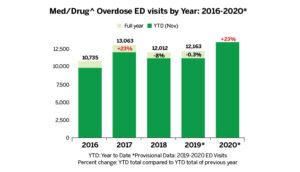
RALEIGH — The U.S. Centers for Disease Control and Prevention (CDC) have issued a report stating that drug overdose deaths have accelerated to a record high during the COVID-19 pandemic.
In December 2020, the CDC reported overdose death rates were the highest ever recorded for a single 12-month period. Between May 2019 and May 2020, around 81,000 people in the United States died due to an overdose.
“The disruption to daily life due to the COVID-19 pandemic has hit those with substance use disorder hard,” said former CDC Director Robert Redfield. “As we continue the fight to end this pandemic, it’s important to not lose sight of different groups being affected in other ways. We need to take care of people suffering from unintended consequences.”
According to the December 2020 CDC report, “Synthetic opioids (primarily illicitly manufactured fentanyl) appear to be the primary driver of the increases in overdose deaths, increasing 38.4 percent from the 12-month period leading up to June 2019 compared with the 12-month period leading up to May 2020.”
During that same time, 37 of the 38 U.S. jurisdictions with available synthetic opioid data reported increases in synthetic opioid-involved overdose deaths, with 18 jurisdictions reporting increases greater than 50 percent. Ten western states saw a more-than-98% increase in synthetic opioid-involved deaths.
Cocaine overdose deaths increased by 26.5%, with likely links to co-use or contamination of cocaine with illicitly manufactured fentanyl or heroin. Psychostimulant overdose deaths, from drugs such as methamphetamines, also increased by 34.8%.
The CDC’s provisional data, which helps predict the death rate trends for such overdoses, lists North Carolina as one of three states with a lower number of reported overdose deaths than were predicted. The state’s predicted overdose death rate for the 12-month period ending June 2020 was 2,374, but the reported rate by the state was 1,928. As with most states, the data for North Carolina is labeled incomplete due to underreporting.
The N.C. Department of Health and Human Services (NCDHHS) maintains a centralized website for drug overdoses, including an Opioid Epidemic webpage and related data subpages. Some of the links on the N.C. Opioid Dashboard, such as data for prescription drug overdoses, appeared either to be down or non-functioning.
In an email response to North State Journal’s inquiry about suicide rates during the pandemic in North Carolina, NCDHHS said that the data on suicides in 2020 is still being finalized, and it “may take a while before we have that information complete.”
Opioid overdose death rates were not found among the data sets, but some emergency room visit data was available.
“The emergency department visits is the most current, as we can get that surveillance through NC DETECT in very timely manner,” wrote NCDHHS press assistant Catie Armstrong. “Deaths have quite a bit of lag, as they take time to be investigated.”
The most current data residing on the poisoning page is for only one month of overdose statistics dating from November 2020; however, most of the data on the page is from 2018. Similarly, the county overdose slides all date back to either 2018 or 2019.

One chart published in December 2020 contained a comparison of November 2019 emergency room overdose visits to that of November 2020. That comparison showed a 23% increase in emergency department overdose numbers during that time.
A second available chart is a Heat Map comparing all opioid-overdose emergency-room visits in North Carolina from December 2019 to that of December 2020. The map shows 658 opioid overdose emergency room visits in December 2020 versus 579 in December 2019: a 13.6% increase. The highest rates of visits (≥10 per 100,000 residents) included Burke (23.2), Randolph (16), Carteret (15.8), Craven (15.5) and Catawba (13.2) counties.
During the same comparison time frame, emergency room visits for heroin, other synthetic and unspecified narcotic overdose rose by 12.5%, from 447 in December 2019 to 503 in December 2020. The highest incidence rates were the same as the opioid instances, including Burke (18.8), Randolph (14.4), Carteret (13.6), Craven (11.9) and Catawba (11.3) counties.
The N.C. Alcohol and Drug Council reports that they have provided almost 9,200 people with information and referrals for substance abuse disorder treatment in the last 12 months. Nationally, 40% of the 5,412 adults who completed a CDC web survey from June 24–30, 2020 reported struggling with mental health issues or substance use.



